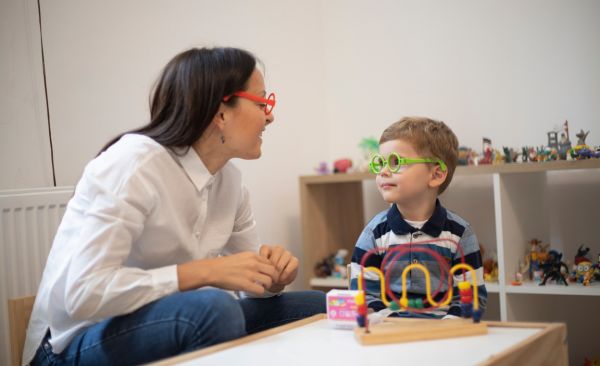What is Play Therapy?
What do you imagine when you think of a typical therapy session? Probably a quiet welcoming office with soft lighting and a comfortable chair or couch. The décor is professional yet calming, with degrees hung on the walls and carefully chosen plants to make the room feel peaceful. The therapist sits across from the client, and they begin to talk for about an hour. The client discusses stress with family, work, or relationships.
The client processes their deep feelings regarding depression, anxiety, low self-esteem, or poor behavioral choices. The client is typically calm, cool, collected and can hold attention to the therapist’s reflections or comments.
Now imagine the client is a 6-year-old child. They are sitting calmly in that chair for an hour and are expressing all their thoughts and feelings as described above.
Hard to picture, right?
Play therapy is an extremely effective model that uses children’s natural and most common mode of communication…play. As the famous quote goes by Gary Landreth, the founder of play therapy, “Toys are children’s words and play is their language.” Children can better express and process their thoughts and feelings in play therapy because they may not be able to put them into words yet.
Play therapy is widely used with children because they feel safer exploring their emotions through play and art rather than expressing them verbally.
Why is Play Therapy powerful?
Play is at the center of childhood. As adults, when we recall positive memories from our childhood, we typically remember times shared with family or siblings that involved play. It could be the family trip to the beach when you played for hours building sandcastles or when your best friend and you played a make-believe game and took turns slaying evil monsters. These moments of play not only provided feelings of joy, comfort, and connectedness, but also boosted learning and imagination.
It is through play that children learn about themselves and the world around them. It guides children to express concerns, fears, wants, and needs. Thus, play is vital to children’s development, as children use play to learn and communicate with their environment. Essentially, there are four therapeutic powers of play:
- self-expression
- creative problem solving
- self-regulation
- social competence
You might be asking, “Well, if the therapist is just playing, can’t I just play with my own child at home?”
This is a wonderful question! When I hear this from parents, I will of course encourage parents to participate in their child’s play. However, in my experience as a play therapist, some parents struggle with how to play meaningfully or therapeutically play.
Perhaps, as a child themselves, play was not encouraged or valued in the home, so parents now struggle with what to do during play. Also, I will discuss with parents how therapeutic play is very different from regular everyday play. For example, when a child plays at home, it can often be alone or with digital or electronic games that lack creativity and imagination.
Play therapists have extensive training and experience to recognize both healthy and unhealthy themes in play and ways to interpret the play using psychological theory and symbolism. By using psychological play therapy interventions, the play therapist promotes appropriate boundaries, emotional regulation, mastery, active listening, empathy, self-expression, and problem-solving. These interventions can be verbal; however, often play therapy utilizes nonverbal and action-oriented interventions.
While adults tend to ‘talk-out’ their difficulties in therapy, children need to ‘play-out’ their thoughts, feelings, or conflicts. The power of play therapy is seen when a trained play therapist assists the child in resolving, rewriting, or repairing trauma experiences or emotional difficulties. Put simply, the power of play therapy is in revealing, expressing, and repairing in a safe, empathic, and predictable environment.
Therefore, play therapy is also powerful because the role of the play therapist is relational. The play therapist is trained by a specific code of psychological ethics that guides the framework for developing a trusting and highly attuned relationship with the child.
What does Play Therapy look like?
Play therapy can look different based on the play therapist’s theoretical model from which they practice and receive training. In general, there are two main approaches, which are categorized as directive and non-directive.
In non-directive play therapy, the play therapist allows the child to lead the play. The child can act out pretend scenarios without the therapist’s influence and develops characters, plots, conflicts, and resolutions. The child can include the therapist as much or as little as they choose. The therapist does not plan the play activities or guide the child to utilize specific toys.
The play session is not restricted to a framework of rules, other than of course safety rules/boundaries. Non-directive, also called child centered therapy, is framed to encourage children’s freedom in play and to promote a non-judgmental attitude over the play. By doing this, the therapist can better understand the child and track their natural unsolicited play themes.
The child is also able to demonstrate more spontaneous positive progress in treatment, because overtime the play will highlight healthier narratives that incorporate effective conflict resolutions, problem solving, and communication. The child’s play narratives will become more cohesive and richer in character development. By leading their own play sessions, the child increases their abilities to self-regulate, build confidence, and repair their once painful experience (i.e., play story) with a healthy, perhaps even happy ending.
In directive play therapy, the difference is straight forward. The therapist provides the child with direction in the play. The therapist will often plan the play activities for each session or choose specific toys for the child.
At times, the therapist will provide the child with a particular prompt to guide the story or conflict in play. The prompt is specifically chosen to reflect or mirror the child’s history, trauma experience, or concerning behavior. Also, the therapist may plan to complete therapeutic worksheets, which is often done with older adolescents.
This approach is attempting to purposefully lead the child to discuss specific areas of concern or process specific events related to that child’s history.
Some play therapists utilize both models depending on the need of the child. Typically, I attempt to maintain as much non-directionality as possible.
But are you curious what is play therapy when it comes to not-so-young-ones? Thing is, I will often use directive play activities with teens ages 13-18 that target specific needs. Adolescents are better able to communicate and process their emotions verbally. Thus, if or when adolescents are vulnerable to ‘play’ they tend to be more comfortable with a directive play activity.
Play therapists use a wide variety of techniques in both directive and non-directive play to engage children in therapeutic play. Common techniques include:
- Sand tray
- Narrative story telling games
- Arts and crafts
- Clay
- Imaginative play
- Dance or movement
- Exploration play
- Mimetic play or modeling
- Rule structured play
Since toys are children’s words, it is vital that the play therapist has a wide range of toys, games, and materials that do not limit self-expression or exploration. The toys in a play therapy room may seem as though they are random and non-important to healing. However, I can assure you that as a trained play therapist, all toys and objects in the playroom have been carefully and thoughtfully hand-picked with meaning.
Some examples of toys used in play therapy include:
- Figurines called ‘miniatures’ of people, structures, animals, mythical creatures, household items, vehicles, seasonal items, landscapes, treasures, and natural materials (rocks, shells, etc.)
- Therapeutic board games
- Dolls and stuffed animals
- Dress-up clothes
- Kitchen sets, food, pretend cooking items
- Cars, trucks, emergency vehicles
- Dollhouse
- Puppets
- Doctor kit
- Blocks
- Puzzles
- Therapeutic books
How does science support healing in Play Therapy?
From a developmental perspective, children should not be treated as miniature adults. They do not possess the same level of rational decision-making, abstract thinking, and language development. Thus, we should not expect children to benefit from the same approaches or things that are beneficial to adults.
Although due to the growing research from neuropsychology, we now know that even adults too can benefit from the properties of play therapy, especially with adults with severe trauma or attachment style difficulties.
Psychologists have learned that neuroscience research supports that play therapy indeed creates new neural pathways in the brain. Play is essential fun, and healthy play lowers Cortical (stress), and increases Dopamine (pleasure), Oxytocin (bonding/connectedness), and GABA (calms nervous system). Research also has demonstrated that play therapy increases whole brain integration, which is when the left-brain (logic, language, personal narratives) connects or speaks to the right-brain (creativity, expression, imagination).
Play therapy has been empirically supported to ‘heal’ by allowing whole brain integration, which creates new neural pathways to better regulate emotions and learn new healthy patterns of behaviors. As the child continues to attend sessions and participate in therapeutic play activities, the process of neural development begins to be repeated. This process can repair old negative experiences that taught the child, adolescent, or adult that their environment or people are unsafe and unpredictable.
What is play therapy then doing for them? It basically rewrites their narratives by rewiring their brains. Play therapy heals by repairing the ‘faulty wiring’ through experiencing alternative experiences by reframing them. Then those new experiences are input into the brain which creates a new neutral pathway.
“What fires together, wires together”
What behaviors or symptoms can Play Therapy treat?
Children who have had complex histories regarding trauma or disruptions in parental attachment are likely to attend play therapy for six months or longer. Other children with more mild difficulties or issues adjusting to changes in their environment may be more appropriate for short-term play therapy. Although play therapy is most widely known with treating individuals who have experienced trauma, it has also been proven effective for a range of other emotional and behavioral issues, including:
- ADHD
- Anger management or mood regulation
- Anxiety
- Depression
- Conduct disorder/defiance
- Social skills deficits
- Low self-esteem
- Loss/grief
- Changes in family dynamic/divorce
- Attachment disorders
- Sexual problematic behaviors
What is Play Therapy: How do I know if it is right for my child?
If play is how children communicate, then in theory, all children can benefit from play therapy. Play therapy is appropriate for children as young as three years old and up until older adolescents.
Signs your child may need play therapy typically involve when they are displaying emotional or behavioral difficulties, or you observe a significant change in their mood or personality. Some specific areas are problems in school, issues being bullied, temper tantrums, aggression/anger outbursts, bedwetting, anxiety, excessive worries/fear, sadness, withdrawal, lack of emotions, hypervigilance, excessive clinginess, low self-worth, difficulties with attention/concentration, inappropriate personal boundaries, or sexually acting out.
Our office specializes in play therapy and working with children and parents and is part of our family counseling services. If you feel your child has been struggling emotionally or behaviorally, we are here to help you.
Please reach out to get more information.
Recommended reads:
The Whole-Brain Child: 12 revolutionary strategies to nurture your child’s developing mind by Daniel J. Siegel


